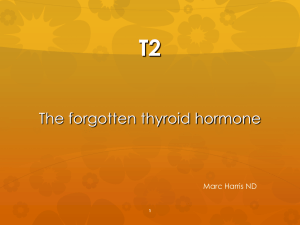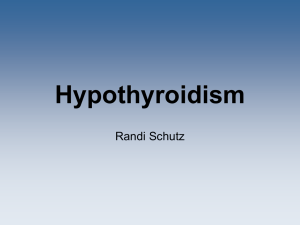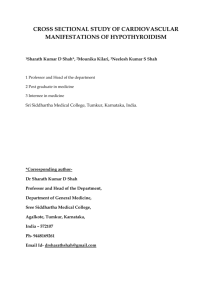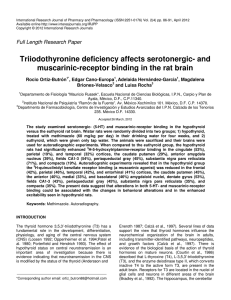Thyroid Hormones
advertisement
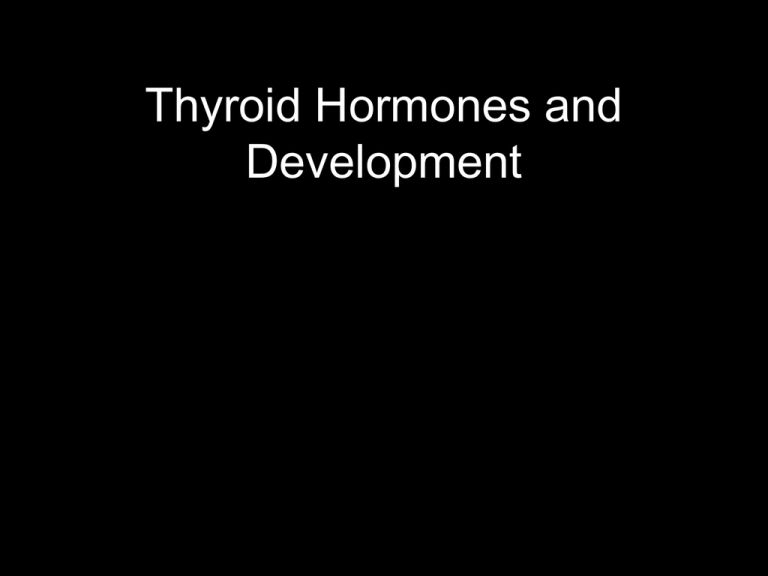
Thyroid Hormones and Development Growth Vs. Maturation Growth refers to increase in the size of a tissue, organ or organism. Maturation refers to emergence of a characteristic through growth or differentiation. V X XV Thyroxine - independent XVIII XX XXI Thyroxine - dependent •apoptosis of tail tissues XXII •mitosis, protein synthesis in limbs •CNS neurogenesis, apoptosis XXIII Shepherd, G.M. (1974) The Synaptic Organization of the Brain From www.1911encyclopedia.org/C/CR/CRETINISM.htm A description from 1855: “ I see a head of unusual form and size, a squat and bloated figure, a stupid look, bleared hollow and heavy eyes, thick projecting eyelids, and a flat nose. His face is of a leaden hue, his skin dirty, flabby, covered with tetters, and his thick tongue hangs down over his moist livid lips. His mouth, always open and full of saliva, shows teeth going to decay. His chest is narrow, his back curved, his breath asthmatic, his limbs short, misshapen, without power. The knees are thick and inclined inward, the feet flat. The large head drops listlessly on the breast; the abdomen is like a bag.” 35 years old, China 15-20 years old, Congo-Kinshasa Causes of Hypothyroidism 1. Dietary deficiency (iodine) 2. Pituitary defect 3. Enzyme deficiency 4. Thyroid autoimmunity 5. Exposure to 131I Table 1 Different experimental model methods for the induction of congenital hypothyroidism. I Models Surgical Method Extirpation of thyroid gland Species Rat Sheep Rabbits References Tsujio et al. 2008 [13] Chen et al. 2007 [14] Zimmermann et al. 2009 [15] II Radioactive Application of iodine Radioisotope 131I Rat Mice Usenko et al. 1999 [16] Usenko et al. 1999 [18] Torlak et al. 2007 [17] III Substance reduction Dietetic reduction of iodine Rat MacLanahan et al. 2008 [20] Wijk et al. 2009 [21] IV Administration of substances Application of Rat - Propylthiouracil (PTU) Mice - Methylimidazole (MMI) Rabbits Kawada et al. 1988 [23] Gilbert et al. 2004 [24] Isaia et al. 2008 [25] Darbra et al. 2003 [47] Hasebe et al. 2008 [26] Bruce et al. 2004 [27] Moriyama et al. 2007 [28] V Genetic Genom manipulation Amendola et al. 2005 [29] Johnson et al. 2007 [30] Mustapha et al. 2009 [31] Mice and Rats G. S. Argumedo1, C. R. Sanz1, H. J. Olguín2 (2012) Experimental Models of Developmental Hypothyroidism. Horm Metab Res ,44, 79-85. Table 2 Congenital hypothyroidism models: advantages and disadvantages. Model Advantages I Surgical Success in elimination of thyroid hormone in blood Disadvantages It is an invasive model. Difficult to complete extirpation of the gland to avoid induction immune response due to remnants, which produce antibodies against the tissue itself. Another disadvantage is the removal of parathyroid gland is related with calcium metabolism together with thyroids Special permission is needed for handling radioactive isotopes and specific skill for the same objective. The consequence of removing parathyroid and parafollicular cells of the thyroid is also a disadvantage It is an expensive diet that is not easy to get References Tsujio et al. 2008 [13] Chen et al. 2007 [14] Zimmermann et al. 2009 [15] Kawada et al. 1988 [23] Gilbert et al. 2004 [24] Isaia et al. 2008 [25] Darbra et al. 2003 [47] Hasebe et al. 2008 [26] Bruce et al. 2004 [27] Moriyama et al. 2007 [28] II Radioactive Damage of thyroid gland with small dose of radioactive iodine giving rise to congenital hypothyroidism in the descendants III Substance reduction The rats witness progressive reduction of iodine without undergoing special handling IV Supply of substances Reproduces many characteristics of CH. The fetus is directly affected no matter the condition of the thyroid of the mother; the rats do not require additional handling. So, the cost does not increase. Treatment is relatively simple to apply. Due to their hydrophilic nature, they can mix up well in solution. Reduction of congenital hypothyroidism with small amount of medicine in the order of micrograms In any methods used, doctors can have errors in administration and dosage, and/or processing. Besides, skin and tissue of mouth can be permeable to substances V Genetic Transgenic animals are Amendola et al. 2005 [29] expensive and not easy to get Johnson et al. 2007 [30] Mustapha et al. 2009 [31] Provokes hypothyroidism through specific damage to the genes, thereby genetically manipulating the animals to obtain an organism expressing the deficiency to study Usenko et al. 1999 [16] Usenko et al. 1999 [18] Torlak et al. 2007 [17] MacLanahan et al. 2008 [20] Wijk et al. 2009 [21] G. S. Argumedo1, C. R. Sanz1, H. J. Olguín2 (2012) Experimental Models of Developmental Hypothyroidism. Horm Metab Res ,44, 79-85. Thyroid Hormone Synthesis Iodine sequestered in the thyroid glane by a Na-I pump, whose activitiy is controlled by TSH thyroid peroxidase tyrosine T4 thyroid peroxidase diiodothyronine de-iodination by tissue tetraiodothyronine (thyroxine, T4) T3 Mechanisms of Hormone Actions 1. 2. 3. 4. Nuclear (regulate gene transcription) protein synthesis Ribosomal (regulate gene translation) Regulate enzymatic activity membrane receptors Alter membrane characteristics Thyroid hormones appear to act directly via T3 receptors, but also indirectly by altering expression of genes for neurotrophins or their receptors. Legend: MS—Medial Septum LS—Lateral Septum DB—ventral Diagonal Band of Broca Camboni, D., Roskoden, T. & Schwegler, H. (2003) Effect of early thyroxine treatment on brain-derived neurotrophic factor mRNA expression and protein amount in the rat medial septum/ diagonal band of Broca. Neurosci. Lett., 350, 141-144. A. BDNF-labelled cells, TH-treated Insert from vDB. B. BDNF-labelled cells, control. Insert from vDB C. BDNF and Trk-B mRNA in P10 rats, MS/vDB D. BDNF labelled cells in P10 and adult (4-mo) rats treated with TH. Tetra-iodothyronine (Thyroxine [T4]) De-iodinated by target tissue Tri-iodothyronine (T3) Cellular effects Gene transcription/translation Cellular metabolism Shepherd, G.M. (1974) The Synaptic Organization of the Brain Altman, J. & Bayer, S.A. (1988) Handbook of Human Growth and Development, Vol. 1, Part A, Pp.1-26 Modified from: Altman, J. & Bayer, S.A. (1988) Handbook of Human Growth and Development, Vol. 1, Part A, Pp.1-26 Stellate, Basket, Some granule Basket Stellate External granule cell layer regenerates, abnormal parallel fibers Some granule Altman, J. & Bayer, S.A. (1988) Handbook of Human Growth and Development, Vol. 1, Part A, Pp.1-26 Altman, J. & Bayer, S.A. (1988) Handbook of Human Growth and Development, Vol. 1, Part A, Pp.1-26 In rats, proliferation after birth accounts for 50% of forebrain cells (mostly glia) 80% of olfactory bulb 97% of cerebellum granule cells : birth-15 days postnatal secondary migration d. 15-30 microneurons: 4-15 days postnatal basket cells: 4-7 days postnatal stellate cells: 8-15 days posnatal Sensitive Period for Thyroid Hormones birth to d. 10 to 12 in the rat first trimester through 6 mo. postnatally in humans period of development normally associated with proliferation apopotosis rapid myelination growth of neuronal processes synaptogenesis proliferation in cerebellum (prolonged by hypothyroidism) Thyroid hormones can exert direct effects on gene expression and protein synthesis, but also indirect effects via receptor-activated second messenger systems. Among the products affected during sensitive period for thyroid hormones are neurotrophins and their receptors NGF, NT family, BDNF, Trk receptors, P75 receptor are all modulated by TH during the sensitive period Escobar, M. de, Ruiz-Marcos, A. & Escobar del Rey, F. (1983) Congenital Hypothyrodism, pp. 85-126 Coulombe, P., Ruel, R. & Dussault, J.H. (1981) Union Med. Can., 110, 658-651. Legrand, J. (1979) Trends in Neuroscience, 2, 234-236. A. B. C. D. E. Control Control Hypothyroid Hypothyroid Hypothyroid + thyroid therapy F. Hypothyroid + thyroid therapy Timiras, P. (1988) Handbook ofHuman Growth and Development, Vol. 1., Part C, Pp. 59-82 Cerebellum of hypothyroid rats retarded, prolonged proliferation of granule cells normal number finally attained but is 25% below normal # on day 14 shorter parallel fibers thus, contacts with fewer Purkinje cells greater cell death during proliferation secondary migration retarded proliferation and growth of stellate and basket cells similarly retarded retarded maturation of Purkinje cells reduced number reduced dendritic growth, fewer targets for parallel fibers could be factor in greater death of granule cells along with shorter parallel fibers (“ripple effects”) Rat Somatosensory Cortex From Wise, Fleshman & Jones (1979) Neuroscience, 4, 1275-1297 Aghajanian, G.K. & Bloom, F.E. (1967) Brain Research, 6, 716-727. From Wise, Fleshman & Jones (1979) Neuroscience, 4, 1275-1297 Rat Somatosensory Cortex From Wise, Fleshman & Jones (1979) Neuroscience, 4, 1275-1297 Rat Somatosensory Cortex Escobar, M. de, Ruiz-Marcos, A. & Escobar del Rey, F. (1983) Congenital Hypothyroidism, pp. 85-126 Neocortex of hypothyroid rats pyramidal cells--largest in cortex--draw on board small, densely packed (fewer glia, less neuropil dendrites shorter, fewer high-order branches (concentric ring analysis) fewer dendritic spines # of potential synaptic contacts reduced by 85% less spatial summation, neural integration reliability of processing reduced range of effective stimuli reduced Neocortex of hypothyroid rats axons myelination greatly reduced slower conduction velocity with low metabolic rate, accounts for sluggishness note that these are same features that distinguish the mature from the immature brain thus, it is as though development is arrested much like that of the athyroid tadpole Gross Characteristics of a “Cretinoid” Rat face foreshortened (brachycephaly) lethargic hair is thin learning & memory impaired brain wt. reduced growth retarded after 12 to 15 d. of age (after several mo. in humans) apparent by 18 mo, but by then too late O2 consumption (metabolism) lowered, cold intolerance deafness delayed somatic maturation as indicated by delayed eye, ear, vaginal opening delayed endochondral ossification Behavior of a “Cretinoid” Rat fits of activity when stimulated, susceptible to seizures startle response, righting reflex, placing responses all retarded persistence of mass-action wriggling to noxious stimulus deficits in both learning and memory Human Behavioral Phenotype The mental capacity varies within narrow limits; an intelligent adult cretin may reach the intellectual development of a child 3-4 years of age, though more often the standard attained is even below this. The child cretin learns neither to walk nor talk at the usual time. Often it is unable even to sit without support. Some years later a certain power of movement is acquired, but the gait is waddling and clumsy. Speech is long delayed, or in bad cases may be almost entirely lacking. The voice is usually harsh and unpleasant. Of the senses smell and taste are but slightly developed, more or less deafness is generally present, and only the sight is fairly normal. In the adult the genital organs remain undeveloped. If the cretin is untreated he rarely has a long life, thirty years being an exceptional age. Death results from some intercurrent disease.





